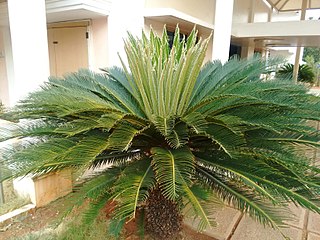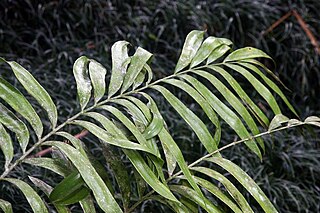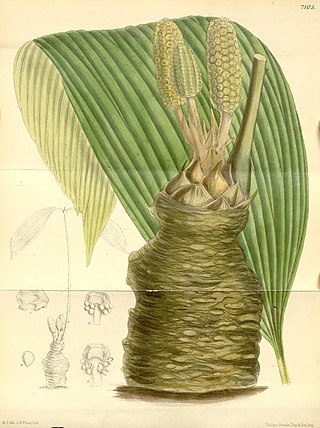
Cycas is a genus of cycad, and the only genus in the family Cycadaceae with all other genera of cycad being divided between the Stangeriaceae and Zamiaceae families. Cycas circinalis, a species endemic to India, was the first cycad species to be described in western literature, and is the type species of the genus.

The Zamiaceae are a family of cycads that are superficially palm or fern-like. They are divided into two subfamilies with eight genera and about 150 species in the tropical and subtropical regions of Africa, Australia and North and South America.

Zamia is a genus of cycad of the family Zamiaceae, native to North America from the United States throughout the West Indies, Central America, and South America as far south as Bolivia. The genus is considered to be the most ecologically and morphologically diverse of the cycads, and is estimated to have originated about 68.3 million years ago.

Zamia acuminata is a species of plant in the family Zamiaceae which is threatened by habitat loss. It is found in Costa Rica and Panama.

Zamia amplifolia is a species of plant in the family Zamiaceae. It is endemic to the Calima River watershed of Valle del Cauca Department, Colombia.

Zamia angustifolia is a species of plant in the genus Zamia. It is found in the Bahamas, where it is threatened by habitat loss, and in Cuba, where it is abundant.
Zamia lucayana is a species of plant in the family Zamiaceae, part of the Zamia pumila species complex. It is endemic to the Bahamas, and is endangered by habitat loss. Z. lucayana is known locally as "bay rush".

Zamia manicata is a species of plant in the family Zamiaceae. It is found in Colombia and Panama. Its natural habitat is subtropical or tropical moist lowland forests.

Zamia neurophyllidia is a species of plant in the family Zamiaceae. The original description was based on specimens found in Costa Rica, Nicaragua, and Panama. A more recent re-characterization of Z. neurophyllidia is based on a population found in the type locality in Bocas del Toro Province, Panama. It is part of the Zamia skinneri species complex.

Zamia roezlii (chigua) is a species of cycad, a palm-like pachycaulous plant in the family Zamiaceae. It is found in Colombia and the Pacific coast of Ecuador. It is named for the Czech botanist Benedikt Roezl. A single sperm cell from Zamia roezlii is about 0.4 mm in length and is visible to the unaided eye, being the world's largest plant sperm cell. Drosophila bifurca, a species of fruit fly, has sperm that are 5.8 cm long, albeit mostly coiled tail. The tree is up to 22 feet in height with fronds up to ten feet long bearing leaflets up to twenty inches long and six inches wide.

Zamia skinneri is a species of plant in the family Zamiaceae. It is endemic to the coastal area of mainland Bocas del Toro Province, Panama. Its common name is cebolla roja.

Zamia wallisii is a species of plant in the family (Zamiaceae) that is commonly known as the chigua. It is endemic to Colombia.
Zamia hamannii is a species of cycad in the family Zamiaceae. The only known population grows in a small area on an island on the northwestern Caribbean coast of Panama. Most plants of the species grow in forest, but some live on sandy beaches. It was named and described in 2008.
Zamia nesophila, common name "guade teet", is a species of cycad in the family Zamiaceae. It is endemic to several islands in northwestern Panama. Most plants grow on sandy beachs close to the sea, although some grow inland in forests. The species is critically endangered due to seaside development.
Zamia restrepoi is a species of cycad in the family Zamiaceae.

Zamia integrifolia, also known as coontie, is a small, tough, woody cycad native to the southeastern United States, the Bahamas, Cuba, the Cayman Islands, and Puerto Rico.
Restrepophyllum is a genus of fossil foliage attributable to the Zamiaceae. This genus is found in Early Cretaceous rocks from Argentina.
Zamia imbricata is a species of plant in the family Zamiaceae described in 2021. The stem is subterranean, the leaves have overlapping leaflets, and the reproductive cones are held on very long stalks. Its natural habitat is tropical rainforest in Colombia. It is very rare, and the known population does not appear to be successfully reproducing.
Zamia sinuensis is a species of plant in the family Zamiaceae described in 2021. The stem is subterranean or partly suterranean, with dark green compound leaves up to 3 metres (9.8 ft) long. and reproductive cones on long stalks. Its natural habitat is tropical monsoon forest in Colombia. Only five plants have been observed.











